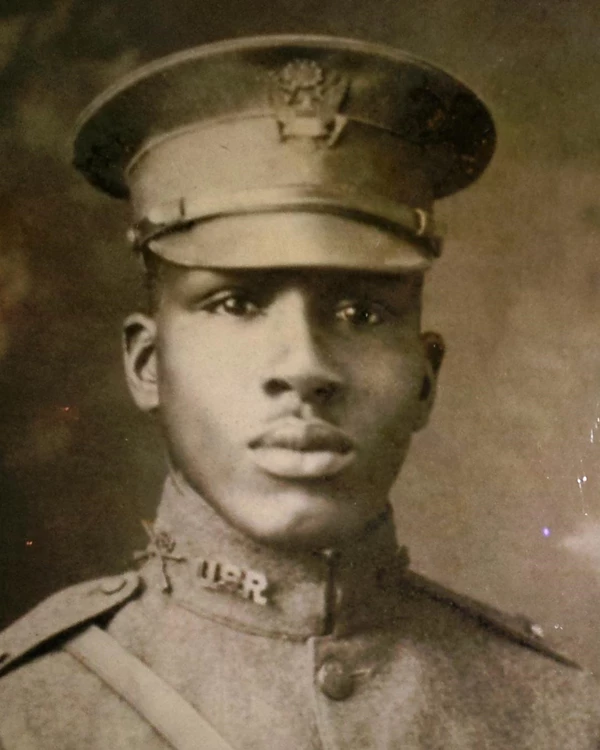Last updated: April 26, 2022
Person
Aaron R. Fisher

U.S. Army
Aaron Richard Fisher was born on May 14, 1892, in Lyles, Indiana, to Benjamin Fisher and Macy Octiva Barnhill Fisher. Benjamin Fisher was from Kentucky and served in the Sixth U.S. Colored Cavalry during the Civil War. Aaron Fisher worked on the family farm when not going to school. Fisher’s mother died on March 30, 1902, when he was 10 years old. He continued his schooling through his sophomore year of high school, after which he worked on the family farm.
On February 28, 1911, Fisher enlisted in the U.S. Army at Jefferson Barracks south of St. Louis in Lemay, Missouri. He received basic training in Leon Springs, Texas, and later at Camp Sherman in Chillicothe, Ohio. After training, Fisher was assigned to the Ninth U.S. Cavalry and shortly after transferred to the Twenty-Fourth U.S. Infantry. Both units were all-Black and known as Buffalo Soldiers. On September 13, 1914, he was promoted to corporal in the Twenty-Fourth Infantry.
With the rest of the Twenty-Fourth Infantry, Fisher took part in the 1916 Punitive Expedition into Mexico, under General John J. Pershing, to capture the Mexican revolutionary Francisco “Pancho” Villa. Villa and his group had attacked Columbus, New Mexico. The Twenty-Fourth Infantry was in Mexico near Palomas, Mexico, until February 5, 1917, when they withdrew back to the United States without capturing Villa.
As the U.S. Army mobilized for World War I, it determined not to involve the Twenty-Fourth Infantry or the other Buffalo Soldiers in the fight. Instead, the Army formed the 92nd and 93rd Infantry Divisions, all-Black segregated divisions it would send to Europe in mostly support roles. In January 1918, Fisher was promoted to first sergeant and transferred to Company E, 366th Infantry Regiment, 92nd Division. Soon after, he was sent to the Officer Candidate School at Fort Des Moines in Iowa. He graduated from there on May 19, 1918. On June 1, he was commissioned as a second lieutenant in the 366th Infantry.
On June 15, 1918, the 366th departed Hoboken, New Jersey, for the port of Saint Nazaire, France. On September 3, 1918, Fisher and his company were on the front line near Lesseux, France, when the Germans attacked their position. Fisher’s unit was greatly outnumbered but he refused to retreat and give up their position. Fisher and his company held their ground until other members of the 366th could swing the balance of the battle with a counterattack. This counterattack sent the Germans into retreat. Fisher was wounded and suffered the effects of poison gas during the attack. He was transferred to Base Hospital No. 45. After recovering from his wounds, he remained in Europe with the Army of Occupation until he returned to the United States on February 28, 1919.
Lieutenant Fisher was awarded the Distinguished Service Cross for his actions in France. His citation for extraordinary heroism stated, “Lieut. Fisher showed exceptional bravery in action when his position was raided by a superior force of the enemy by directing his men and refusing to leave his position although he was severely wounded. He and his men continued to fight the enemy until the latter were beaten off by counterattack.” Fisher also received the Purple Heart and the French Croix de Guerre with gold star.
On March 17, 1919, Fisher was honorably discharged as a captain in the Army reserve. He reenlisted in the regular Army on June 12, 1919. This time he was a sergeant in Company F, Twenty-Fourth U.S. Infantry. He continued to be promoted in the Twenty-Fourth Infantry and from September 1923 to June 1924 he attended the Quartermaster School in Philadelphia, Pennsylvania. After graduating from the Quartermaster School, he was stationed at Camp Little and Fort Huachuca, both in Arizona. In the early 1930s, he was stationed in New Mexico, and Louisiana, and completed a two-year tour of duty in the Philippines.
On June 29, 1936, Fisher was assigned to Wilberforce University as professor of military science. He oversaw the University’s Reserve Officers’ Training Corps (ROTC), which then-Colonel Charles Young established in 1894. Fisher instructed countless African Americans who went on to serve bravely throughout World War II. The most famous student Fisher trained was Lieutenant John R. Fox, who was eventually awarded the Medal of Honor for his actions in Sommocolonia, Italy in 1944. Fisher taught at Wilberforce University until December 31, 1947, when he retired from the Army.
After his retirement from the military, Fisher stayed in the Wilberforce University area. In 1948, he worked as a civilian employee at Wright Patterson Air Force Base. He was also appointed by the Greene County, Ohio, commissioners to coordinate the county’s work relief program. He died on November 22, 1985, at the age of 89. He was buried Valley View Memorial Gardens in Xenia, Ohio.
